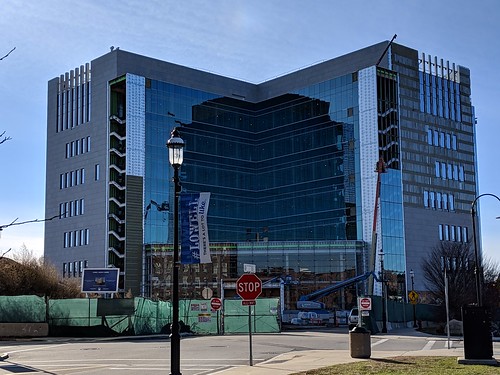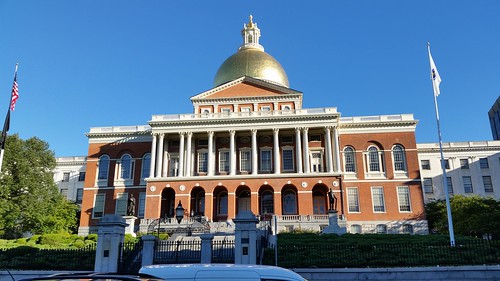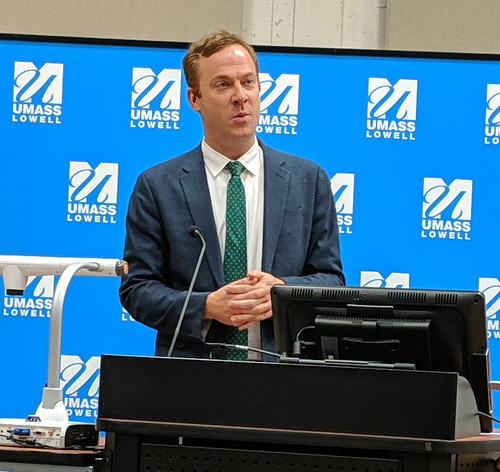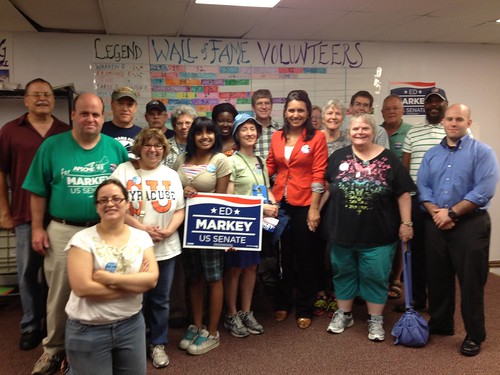Lowell Week in Review: January 13, 2019

Lowell Judicial Center
Hamilton Canal update
At Tuesday’s Lowell City Council meeting, we learned a couple of things about projects in the Hamilton Canal District. First, the finish date for the Judicial Center has been pushed back, I think for 90 days. That would make its grand opening at the end of March 2020, about 14 months from now.
While that’s a relatively minor setback, the news about the city’s new parking garage for the Hamilton Canal District was a bit more concerning: the initial bids for the garage all came in over budget. City Manager Eileen Donoghue said the design of the garage is being revisited to try to cut costs. While that may be necessary, it’s never good news. So say goodbye to ground floor retail and perhaps even a floor or two of the garage.

Boston skyline – construction is booming
As for why the bids came in over budget, all you have to do is look 25 miles south of here to Boston. When you ride the train to North Station, the last mile is one new high rise apartment building after another, all under construction. It’s a good time to own a construction company or to be in the building trades. When you can get top dollar on a project in Boston, there is little attraction to one in Lowell so maybe you’re not as frugal in crafting your bid for a Lowell parking garage as you would be if you were really looking for work.
But as Mimi pointed out in her Thursday column (“City Government Quick Hits”), the history of the Hamilton Canal District has been two steps forward then one step back (have we ever landed a new Master Developer?) so while the garage bids are a setback, they should not halt the momentum of the project.
Unfortunately, it seems that some councilors don’t see it that way. Consider the opposition to a very important motion Tuesday night by Vesna Nuon about the parking situation for the Judicial Center. Here’s the text of his motion:
Req. City Mgr. establish a working group to examine Judicial Center parking in the Hamilton Canal District, over the short and long term, and provide policy and planning guidance and coordination; advisory body should include representatives from DPD, DCAM, LRTA, parking authority, courts, HCD commercial and residential communities and any others as determined by the City Manager.
The motion seeks the creation of an “advisory” group consisting of representatives from the city’s Department of Planning and Development (DPD); the state’s Division of Capital Asset Management (DCAM – the state agency overseeing construction of the new courthouse); the Lowell Regional Transit Authority; the city’s parking authority; the state’s Trial Court (which will be the primary occupant of this building); and current and proposed commercial and residential entities in the vicinity of the Judicial Center, to meet from time to time to provide advice on parking in both the short and long term.
The reason this is such an important motion is that when the Judicial Center is fully occupied, an estimated 1400 people per day will be coming to it. That number includes employees, litigants and jurors. Some portion of them are already in Lowell, doing business in the three Lowell courthouses that will be consolidated in the Judicial Center (Superior, District and Juvenile courthouses), but there will be many more people in that new building. For example, the probate court which now comes to Lowell every other Friday for a few hours with a single session will have a full six court sessions every day in the new building. (That’s partly because the Probate Courthouse in Cambridge is scheduled to close at the same time the Lowell Judicial Center is to open, so much of that work will be shifted to Lowell from Cambridge).
Even after the new garage is built, there will still be major parking problems. For instance, the new garage is supposed to have 900 spaces, not nearly enough to accommodate even the 1400 people coming to the Judicial Center every day. Yet that new garage won’t be for the exclusive use of Judicial Center visitors. The National Park will have a number of spaces; other buildings in the HCD will need spaces in it; and people who work in other parts of downtown who can’t find room in the current Market Street garage will want to park there too.
We know that this parking crisis is coming, so shouldn’t we begin planning for it in detail? Shouldn’t we include the representatives of the people who will be most affected by it in that planning process? Shouldn’t that have started months ago never mind right now? I would think reasonable people would agree that the answer to all three of those questions would be yes. Any fair reading of Councilor Nuon’s motion would seem to have that as its objective. Yet while the motion did pass, three councilors (Dave Conway, Rodney Elliott and Rita Mercier) all voted against it without any explanation other than this advisory group might usurp the authority of the City Manager.
Notwithstanding the opposition of one-third of the council, I hope the City Manager quickly convenes the group described in Councilor Nuon’s motion and starts contingency planning. At a minimum, that would communicate to all of these people from outside of Lowell that the city of Lowell is interested in welcoming them to the city and making their transition to a new workplace as smooth as possible.

Education Funding
We’ve long known that the Commonwealth’s formula for supporting the cost of K through 12 public education is outdated. Enacted in 1993, the state’s landmark education bill made certain assumptions about the cost of providing a public education. In the quarter century since then, the cost of many items, especially healthcare and special education, greatly exceed the costs assumed by the 1993 act. The financial burden of this outdated law is felt most heavily by urban communities such as Lowell.
For that reason, it was encouraging to learn this week that one of the first actions by newly elected State Senator Ed Kennedy was to co-sponsor (along with Sen. Sonia Change-Diaz of Boston, and representatives Aaron Vega of Holyoke and Mary Keefe of Worcester) the Education PROMISE Act which would modernize the state’s education funding formula so that it better reflects reality.
Updating the education funding formula will get widespread support. Just check out this paragraph from a story in Thursday’s Globe (“Beacon Hill looks to tackle school funding formula in new session”):
“[Governor Charlie Baker] said he plans to file a bill to rewrite the funding formula – a signal that he is interested in going further than the changes he has proposed in the past. House Speaker Robert A. DeLeo has voiced support for tackling the issue. Senate President Karen E. Spilka says it’s a top priority for her chamber.”
Great. But while everyone is on board with changing the formula, not everyone is on board with paying for such changes. We’re talking about spending more state money on education. Where is this new money coming from? It would seem the only realistic source (and the proper one) will be to raise taxes to generate the needed new revenue. But I suspect that neither Governor Baker nor Speaker DeLeo will support a tax increase for this or any other reason. (The State Senate has lately seemed much more realistic about a willingness to pay for things that are proposed, rather than just having a press conference about the proposal and then hoping everyone forgets the proposal was never implemented due to a lack of funding). So if you support revising the education funding formula, the next time you’re talking to your State Representative, whomever that might be, ask him or her two questions: Do you support updating the education reform foundation budget formula? Do you support raising taxes to pay for it?

AP White House correspondent Jonathan Lemire
The White House Comes to Lowell
Jonathan Lemire, a Lowell-native and the current White House correspondent for the Associated Press and a regular contributor on MSNBC, returned to Lowell on Thursday to speak to the Learning in Retirement Association (LIRA) at UMass Lowell.
Here’s what those who attended the talk learned:
Lemire grew up in Lowell, attended Central Catholic High School in Lawrence and Columbia University in New York City. He always was interested in writing and at Columbia, he began covering sports. He quickly realized that covering sports tended to deaden one’s love for sports, so he switched to news.
When Lemire graduated in May 2001, the economy had cooled after the bursting of the dot-com bubble, but he ended up with a $200 per week internship at the New York Daily News, one of the city’s tabloids. His internship was nearing its end on September 11, 2001, but that day changed his life as it did the lives of so many others.
Becoming a full time employee of the Daily News, Lemire spent the next several months covering the funerals of the hundreds of New York City Firefighters who died at the World Trade Center. He stayed with the Daily News for the next decade, covering local news and politics but also the 2012 presidential election.
In anticipation of the 2013 New York City mayoral election (which was won by Bill de Blasio), the Associated Press hired Lemire to cover that race. He continued writing about New York City for the AP including extensive coverage of Michael Bloomberg’s flirtation with the presidency. This attracted the attention of the AP’s Washington bureau which recruited Lemire to cover Donald Trump’s presidential campaign.
Having covered NYC for nearly 15 years, Lemire was already familiar with Trump having interviewed and written about Trump. He described Trump as someone who was never completely accepted by the inner circle of power in Manhattan, where he was seen as someone who lived for publicity.
According to Lemire, Trump made the media a big part of his 2016 presidential campaign. He represented the distrust of institutions felt by his followers. Lemire said that after the national convention, the pace of the campaign really picked up and “you could see that there was something there.” In places like Pennsylvania, Ohio and Florida, places where the Republicans often struggled, Trump was generating enormous energy and enthusiasm.
Trump’s advisors kept telling the reporters that polling was missing much of Trump’s support. Lemire confirmed this by repeatedly finding people at Trump events who said they hadn’t voted in years but who were enthused about Trump as never before. As election day approached, Lemire was telling colleagues that Trump was going to win.
Believing otherwise, the AP planned to assign Lemire to the “Trump in Defeat” beat in NYC. When Trump won, his employers assigned him to cover the White House but to remain based in NYC since they expected the president to return there repeatedly. Although he does not (Lemire attributes that to the virulence of the protests against Trump anytime he has returned to NYC, nevertheless, Lemire has remained in NYC and has become a frequent rider on the NYC to DC Amtrak service.
The past two years have been “unique.” Veteran White House reporters say they’ve never seen anything like this. That’s partly because of the immediacy of the media, social media and the 24/7 news cycle. He said Trump lives to dominate the news minute-by-minute. Lemire believes this is why Trump lies so often: he will say whatever he thinks will dominate the headlines at that moment in time regardless of the truth of what he asserts. While Trump seems to have done this with impunity, Lemire believe there have been three controversies that will damage Trump long term:
- The child separation policy at the border
- At a joint press conference in Helsinki with Vladimir Putin, on a question (be Lemire) of whether Trump believed his own intelligence agencies or Putin, Trump sided with Putin
- After violence erupted at a Unite the Right rally in Charlottesville, Trump refused to condemn the white nationalists and neo-Nazis and said “there were fine people on both sides.”
Lemire’s was an excellent, insightful presentation. Watch for him on MSNBC.
Always a Lowell Connection

Tulsi Gabbard for President website
The newest entrant into the race for the Democratic nomination for President in 2020 is Congresswoman Tulsi Gabbard, a four-term member of Congress from Hawaii. Gabbard is the first Samoan American member of Congress and the first Hindu member of Congress. She’s also a U.S. Army combat veteran. And if you read the first few paragraphs of her Wikipedia entry, you’ll see that she’s controversial for a number of reasons.

Congresswoman Tulsi Gabbard with Ed Markey for Senate volunteers in Lowell, June 13, 2013
The reason I mention Congresswoman Gabbard is that she visited Lowell not long ago. It was in the summer of 2013 in the midst of the special U.S. Senate election to fill the seat vacated by John Kerry when he became Barack Obama’s Secretary of State. Tulsi came to Massachusetts to campaign for her then Congressional colleague Ed Markey who was seeking the Senate seat. From the 30 minutes she spent here it was evident that she was charismatic, a powerful speaker and a good campaigner. I doubt she has a realistic shot at becoming the nominee, but I thought the same about Donald Trump so stranger things have happened.